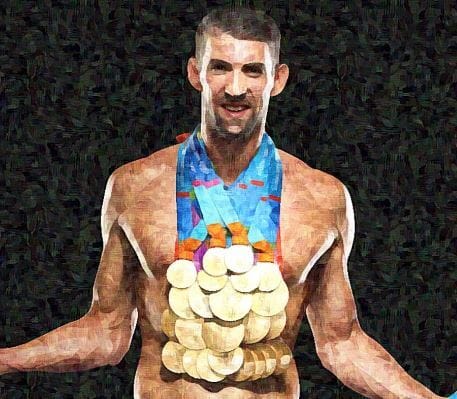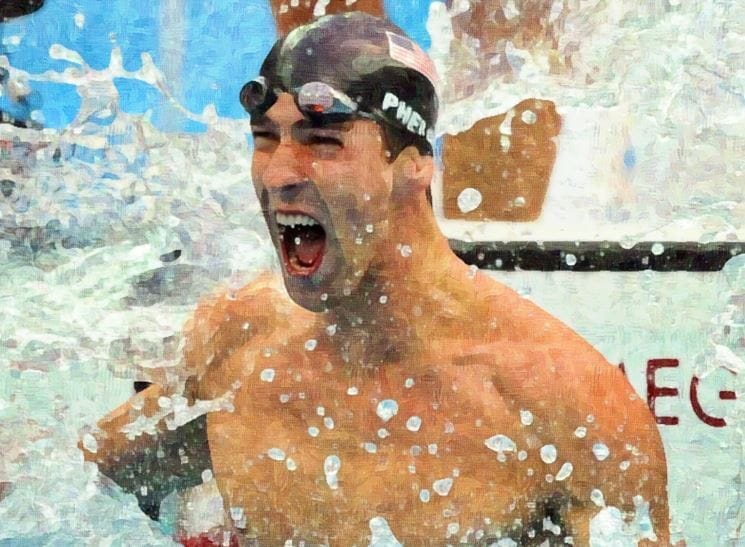A young boy, with ears that seemed too large for his head, standing on the edge of a swimming pool. He's nervous, fidgeting, the water reflecting his uncertainty back at him. But as he dives in, something magical happens. He becomes one with the water, gliding seamlessly across the surface. That little boy was Michael Phelps, and his journey from shy kid to the greatest swimmer of all time is nothing short of extraordinary. It’s a tale that doesn’t just float but dives deep into the essence of human determination and transformation.

Michael Phelps posing with his 23 Olympic gold medals
Background and Context
Michael Fred Phelps II was born on June 30, 1985, in Baltimore, Maryland. The youngest of three siblings, Phelps grew up in a family that encouraged athleticism and competitiveness. His two older sisters, Whitney and Hilary, were swimmers themselves, and it wasn't long before young Michael dipped his toes into the water. However, life was not always smooth sailing for the Phelps household.
Michael's parents divorced when he was young, leaving his mother, Debbie, a middle school principal, to care for him and his sisters. Despite the family upheaval, Debbie was a pillar of strength and support. She recognized Michael's potential early on, especially when he was diagnosed with Attention Deficit Hyperactivity Disorder (ADHD). Instead of treating it as a hindrance, Debbie saw it as an opportunity to channel Michael's boundless energy into something productive.
Swimming became Michael's sanctuary, a place where he could focus and excel. By the age of seven, he was already breaking records in local swimming competitions. Debbie, who had to juggle her job and the demands of raising three children, made sure that Michael got to his swim practices on time. Her unwavering belief in his talent laid the foundation for his future success.
The Challenge or Turning Point
As Michael transitioned from a promising young swimmer to an Olympic hopeful, he encountered challenges that would test his resilience. His ADHD sometimes made it difficult for him to concentrate, especially during long training sessions. Yet, under the guidance of his coach, Bob Bowman, Michael learned to use his condition to his advantage. He developed an intense focus in the pool, breaking down each race into manageable parts, a technique that would later become one of his trademarks.
However, the true turning point in Michael's life came in 2000 when, at the age of 15, he qualified for the Sydney Olympics. The world watched as this gangly teenager with a competitive spirit took on seasoned athletes. Although he didn't win a medal, his performance was enough to signal the arrival of a new swimming prodigy.
Michael's journey was not without personal struggles. The pressure of being in the public eye, coupled with the expectations to deliver gold medals, weighed heavily on him. He experienced moments of self-doubt and even battled with depression. In 2004, after a string of world-record performances, Michael found himself questioning his purpose and direction. It was a dark period where he considered stepping away from the sport altogether.
The Journey of Overcoming
Despite these challenges, Michael's resolve to overcome them became the cornerstone of his success. He realized that swimming wasn't just about winning medals; it was about pushing his limits and breaking barriers. This mindset shift allowed him to approach his training with renewed vigor and purpose.
Under the mentorship of Bob Bowman, Michael honed his skills and developed a rigorous training regimen that included swimming up to 80,000 meters a week. He adopted a disciplined lifestyle, focusing on nutrition, rest, and recovery, all of which played a crucial role in his athletic performance. Michael's work ethic and perseverance became legendary, inspiring a generation of swimmers to dream big.
One of Michael's most remarkable comebacks came at the 2008 Beijing Olympics. After a (“relatively”) disappointing performance at the 2004 Athens Games, where he won six gold and two bronze medals, Michael was determined to leave a lasting legacy. In Beijing, he achieved the impossible: winning eight gold medals in a single Olympics, breaking Mark Spitz's record of seven golds from the 1972 Munich Games. His performance was nothing short of spectacular, a testament to his dedication and relentless pursuit of excellence.
Achievements and Impact
Michael Phelps' impact on the world of swimming is unparalleled. Over his career, he accumulated 23 Olympic gold medals, making him the most decorated Olympian of all time. But his influence extends far beyond the pool. Michael has become a vocal advocate for mental health awareness, openly discussing his struggles with depression and anxiety. He has shown that even the most successful individuals face obstacles, and seeking help is a sign of strength, not weakness.
Through the Michael Phelps Foundation, established in 2008, he aims to promote healthy lifestyles, especially among children. The foundation's signature program, "IM," teaches kids the importance of physical activity, healthy eating, and water safety. Michael's commitment to giving back to the community has made him a role model, not just for aspiring athletes but for anyone facing life's challenges.
Michael's story is one of resilience and transformation. He inspires others to see that setbacks are merely stepping stones to greater achievements. His ability to adapt, learn, and grow in the face of adversity is a powerful reminder of the human spirit's potential to overcome any obstacle.
Conclusion
Michael Phelps' journey from a timid boy with ADHD to the most celebrated swimmer in history is a story of perseverance, courage, and unwavering dedication. His life teaches us that success is not a destination but a continuous journey of self-improvement and growth. As Michael continues to redefine what it means to be a champion, he reminds us all that the true measure of success is not how many times we fall, but how many times we rise.
Personal Insights, Quotes, or Lessons
Today, Michael Phelps continues to inspire others through his advocacy work and motivational speaking. He is a devoted husband and father, finding joy in his family and his role as a mental health advocate. He once said, "You can't put a limit on anything. The more you dream, the farther you get." It's a mantra that resonates with anyone striving to defy the odds and achieve their dreams.
Michael Phelps' story is a testament to the power of resilience and the enduring human spirit. He shows us that with determination and hard work, we can overcome any obstacle and leave a lasting impact on the world.
Lessons Learned
These structured lessons from Michael Phelps’ life offer a roadmap for personal and professional growth. By integrating these principles, you can leverage your unique strengths, adapt to challenges, and make a positive impact in the world.
The Visionary's Perspective:
Key Lesson: Recognizing Opportunities in Adversity
Takeaway Statement: Michael Phelps saw his ADHD not as a barrier but as an opportunity to channel his energy and focus into swimming, turning a perceived weakness into a strength.
Example from Their Life: Billie grew up in challenging circumstances, but she found solace in music from a young age, listening to Bessie Smith and Louis Armstrong. Her unique approach to music—bending notes and infusing emotion into every phrase—set her apart from the traditional singers of her time. This distinct style caught the attention of producer John Hammond, helping her launch her career.
How to Apply This: To develop foresight and strategic thinking, start by identifying what others might perceive as a limitation or setback in your life. Reframe it as an opportunity to grow or excel in a new area.
Action Step: List any current challenges you face. Next to each, write one potential positive outcome or opportunity that could arise from embracing or overcoming that challenge.
The Competitive Edge:
Key Lesson: Building Discipline Through Consistent Effort
Takeaway Statement: Michael’s unmatched work ethic and discipline, characterized by rigorous training and lifestyle choices, were fundamental to his success.
Example from Their Life: Michael followed a strict training regimen, swimming up to 80,000 meters a week, and focusing intently on nutrition, rest, and recovery. This disciplined approach enabled him to reach unprecedented levels of performance.
How to Apply This: Establish a routine that incorporates discipline into daily activities. Focus on consistency over intensity to gradually build habits that align with your goals.
Action Step: Choose one small habit that aligns with your larger goal (e.g., reading 10 pages a day for intellectual growth) and commit to doing it daily for 30 days to establish consistency.
The Strategic Risk-Taker:
Key Lesson: Embracing Calculated Risks
Takeaway Statement: Michael Phelps strategically embraced the risks of competing at the 2000 Sydney Olympics at just 15, understanding it as an invaluable experience despite not winning a medal.
Example from Their Life: Participating in the Sydney Olympics exposed Michael to high-level competition and signaled his arrival on the world stage, setting the foundation for his future success.
How to Apply This: Approach risks with a mindset focused on growth and learning. Evaluate the potential benefits against the risks and outline how the experience can help you grow, irrespective of the outcome.
Action Step: Identify one risk you’ve been hesitant to take. List the potential growth opportunities it offers and commit to taking one small step towards it this week
The Impact-Driven Leader:
Key Lesson: Leveraging Success to Inspire and Uplift Others
Takeaway Statement: Beyond his swimming accolades, Michael Phelps utilized his platform to advocate for mental health and promote healthy lifestyles through his foundation.
Example from Their Life: The Michael Phelps Foundation’s "IM" program focuses on encouraging children to engage in physical activity and learn about water safety, showcasing his commitment to giving back
How to Apply This: Find ways to use your skills and successes to contribute positively to others’ lives. Consider mentorship, community service, or advocacy based on your passions.
Action Step: Volunteer for a local organization that aligns with your interests or offer your expertise to mentor someone in your field.
The Adaptive Innovator:
Key Lesson: Continuous Learning and Adaptation
Takeaway Statement: Michael Phelps continuously evolved his training and mindset to remain ahead of the competition, even in the face of personal and professional challenges.
Example from Their Life: After a disappointing performance in Athens in 2004, Michael adapted his approach and came back stronger in Beijing in 2008, achieving record-breaking success.
How to Apply This: Embrace change and seek new learning opportunities. Stay open to feedback and use it to pivot and grow.
Action Step: Dedicate time each week to learning a new skill or expanding your knowledge in a particular area—whether through reading, online courses, or practical application.
Thank you for reading this edition of Modeling Winners. If you enjoyed what you read, please consider subscribing. We post inspirational stories throughout the week. The best part? It’s FREE!
If you are already a subscriber, please consider whitelisting our emails so they go directly into your primary inbox.
Want to share this specific article? Copy the link below to share:
Want to view the Modeling Winners newsletter as an app on your mobile device? Here’s how!
For iOS:
Open Safari and go to the web page.
Tap the Share button (square with an arrow pointing up).
Scroll down and select "Add to Home Screen."
Rename it if needed, then tap "Add."
The shortcut will now appear like an app on your home screen.
For Android:
Open Chrome and go to the web page.
Tap the three-dot menu (top right corner).
Select "Add to Home screen."
Rename it if needed, then tap "Add."
Choose "Add automatically" or drag it where you want.



